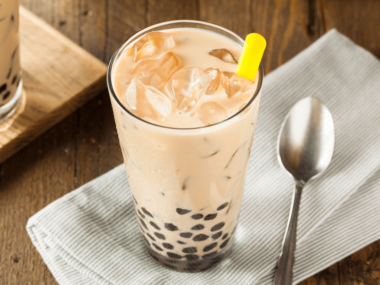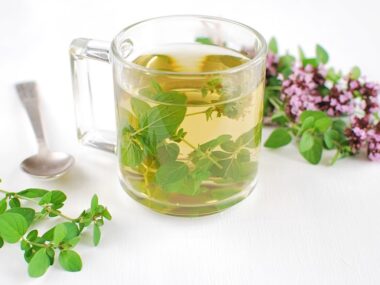The influencers from the Roman era frolicked in bath waters enhanced with what we now enjoy as tea. Egyptians used it to bury the dead. You may be surprised to know that we are talking about the lavender plant and lavender tea!
Table of Contents
What Is Lavender Tea?
Lavender tea is not a true tea but is a tisane (herbal tea.) It is made from the Lavandula plant, which has over 30 different species (followed by subspecies, hybrids, and cultivars.) The fragrant purple flowers of one particular Lavandula species (Lavandula angustifolia) are dried and used for brewing.
Lavender tea is typically enjoyed in its unadulterated form, where the dried lavender flowers and water are the only ingredients. Other teas such as Earl Grey, black, or rooibos may have lavender infused or blended in.
The Lavender Plant
Lavandula (a member of the mint family) is a native plant that grows in parts of Europe, Africa, the Middle East, Asia, and India.
There are four species of Lavandula (lavender).
- Lavandula angustifolia (English lavender)
- Lavandula x. intermedia (hybrid)
- Lavandula latifolia (Spike lavender)
- Lavandula stoechas (French or Spanish lavender)
Lavandula angustifolia is what’s called the “true lavender.” The dried flowers of this plant are brewed into a lovely fragrant tea. When purchasing lavender tea, it’s very important to know what species of lavender the tea was made from.

Lavender tea is not controlled or standardized in the U.S., and because each species has its own set of chemical constituents, one tea (made from one species) may have adverse effects, whereas another (made from a different species) may not.
Tea drinkers are often misled into thinking they are getting a safe and healthy lavender tea just because the packaging says so. Anytime it comes to tisane teas (herbal,) it’s best to do your homework before drinking. This is especially true when it comes to lavender tea. We are going to cover this more in detail further down.
There is very little research that substantiates just how beneficial lavender is. What little scientific data there is, is based on Lavandula angustifolia (without taking the other species into account.) The FDA (Food and Drug Administration) classifies two species of lavender (Lavandula officinalis and Lavandula latifolia) as “generally recognized as safe” when used as intended.
Background Of Lavender
Lavender has a somewhat ambiguous background and history. There’s little known about this aromatic purple flowering plant. What we do know is that the essential oil derived from lavender is highly utilized in aromatherapy, beauty products, shampoos, soaps, air fresheners, and in the food industry.
According to a study done by North Carolina State University’s Extension, lavender has definitely “been around the block or two” in various uses throughout the world. Egyptians have relied on lavender as “old-school” aromatherapy when burned as incense. By adding lavender to adorn bath waters, Greeks and Egyptians alike enjoyed the aroma while bathing.
As the Middle Ages rolled in, lavender was scattered throughout the floors and rooms of castles and areas where the sick lay. It was thought to be disinfecting and filled the rooms with a pleasant aroma. During the war, lavender was used to treat wounds to prevent infection. Many other antiquated uses of lavender included embalming loved ones with the perfumed scent.
Today, lavender is used in a lot of different ways. Everything from massage aromatherapy to cookies include lavender. Traditional medicine uses lavender to treat numerous ailments.

What Does Lavender Tea Taste Like?
When it comes to describing the flavor of lavender, there’s quite a diversity of descriptions. Many say it has hints of rose, citrus, and mint, while the foundational flavors are floral and a bit earthy. It’s as if a variety of flavors collide, confusing the taste buds!
Does Lavender Tea Have Caffeine?
Lavender tea is not a true tea like black or green tea but rather a tisane (herbal tea.) Herbal teas do not contain any caffeine. Being caffeine-free is one of the reasons drinkers choose tisanes—that and the fact that tisanes have medicinal benefits.
Does Lavender Tea Make You Sleepy?
You’ve most likely heard that spraying lavender on your pillow helps you sleep at night. Lavender tea has the same effect. The aroma and flavor of lavender tea are what drive many to drink it. Lavender tea has been found to have a sedating effect. Also note that when purchasing a blend of lavender chamomile tea, it may double the sedative side effect since chamomile also has relaxing properties.
Is it Safe to Drink Lavender Tea?
In general yes, off-the-shelf lavender tea is safe to drink. However, lavender stoechas is a lavender species you will want to steer clear of. This plant is also known by numerous other names.
- Bract Lavender
- Butterfly Lavender
- French Lavender
- Spanish Lavender
- Topped Lavender
This lavender species contains two active ingredients (linalool and linalyl acetate.) When ingested, linalool causes a host of side effects that include drowsiness, dizziness, confusion, and more. Linalyl acetate (when ingested) acts as a sedative.
Additionally, if a particular species of lavender (Lavender stoechas) is used to make tea, you take the risk of suffering what’s called “anticholinergic syndrome” and tachycardia. The onset of symptoms can occur within 2 hours of ingesting and have a lasting effect on the central nervous system for 8+ hours.
Symptoms Of Anticholinergic Syndrome After Ingesting Lavender stoechas
- Burning of the mouth and esophagus
- Nausea
- Vomiting
- Headache
- Rapid heartbeat
- Elevated liver enzymes
- Confusion
- Seizures
- Depression or failure of the respiratory system
- Death
Is Lavender Tea Good For Anxiety?
Yes, this tea is calming, promoting a sense of relaxation. This is due to linalool, linalyl acetate, 1,8-cineole, B-ocimene, terpinen-4-ol, and camphor in lavender which is mildly sedating. Results from a study indicated lavender had the same effect as 0.5mg of Lorazepam (a sedative drug.)
Is It Okay To Drink Lavender Tea Every Day?
Researchers found that boys 7-10 years who had a lavender topical solution applied developed gynecomastia. The study also revealed that ingesting lavender can cause an allergic reaction, nausea, or stomach upset.
So, does lavender tea have side effects? We could not find solid scientific data stating lavender tea causes any unwanted side effects provided the tea is made from Lavandula angustifolia. As we mentioned earlier, other species of lavender (Lavandula) may cause side effects, one being Lavandula stoechas (French/Spanish lavender.)
Lavender Tea Benefits

The lovely scent of lavender is an unexpected surprise when making this tea. However, there’s much more to the tea than meets the eye. So, what is lavender tea good for?
Helps Insomnia
A study conducted found that ingesting 80mg of a lavender oil preparation (oral) had significant benefits. The overall quality and number of hours of sleep benefited while both mental and physical improvements were noted. There were no sedating side effects.
Additionally, the results of the study showed that by replacing prescription sleep aids with lavender aromatherapy, geriatric patients achieved restorative sleep.
Reduces Pain
Researchers proved that lavender oil plays a vital role in the relief of pain and discomfort. Aromatherapy with lavender oil helped to alleviate menstrual pain. Women undergoing C-Section to deliver their babies were subjected to aromatherapy with lavender. Each had a reduction in pain. Opioid addicts were able to help alleviate the drug craving just by inhaling lavender oil.
How To Make Lavender Tea
Trying to find a good lavender tea recipe may be daunting, especially if you’ve never had it. We have a few to share with you that are easy to prepare and quite delicious.
Straight-Up Lavender Tea
Ingredients
- 4 cups of water
- 1 ½ to 2 tablespoons of organic lavender (from Lavandula angustifolia)
- ⅛ teaspoon of honey (optional)
Directions
- Bring the water to a boil.
- Remove from heat.
- Add lavender to a tea infuser and place into hot water.
- Allow the water and lavender to steep for 5 minutes.
- Remove the infuser.
- Pour into a teacup and add honey to sweeten.
- Enjoy!
Tip: This tea is perfect for pairing with a slice of lemon cake.
Lavender Milk Tea
Ingredients
- ¼ cup black tapioca pearls
- 1 cup of water (for brewing the tea)
- 2 tsp. Honey
- 2 tablespoons loose lavender tea (from Lavandula angustifolia)
- 1 cup of milk
- Ice
Directions
- Bring 1 cup of water to boil.
- Remove from heat.
- Place 2 tablespoons of loose lavender into an infuser.
- Drop the infuser into the hot water and allow it to steep for 10 minutes.
- Remove the infuser and set tea aside.
- Prepare tapioca pearls as directed on the instructions, rinse with cold water, drain and set aside.
- Fill a glass with ice.
- Pour 1 cup of milk over the ice.
- Pour lavender tea slowly over the milk.
- Place a dollop of whipped cream on top.
- Insert an extra-wide straw and enjoy!
Tip: There are lavender milk tea powder mixes sold on the market; however, they are high in carbs and sugars. If you are watching your calorie intake, we would not recommend using the powder form. This recipe provides you with a healthier alternative.
“Lavish” Your Tea-Drinking Desires With Lavender!
When you enjoy a cup of lavender tea, you get a double bonus with aromatherapy from the lovely fragrance and the flavor. This tea is all the more wonderful if you grow your own Lavandula angustifolia (lavender) and pick the flowers fresh for a fresh brew!






